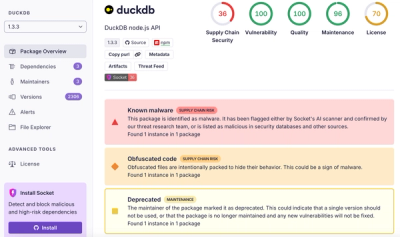
Product
Introducing Tier 1 Reachability: Precision CVE Triage for Enterprise Teams
Socket’s new Tier 1 Reachability filters out up to 80% of irrelevant CVEs, so security teams can focus on the vulnerabilities that matter.
com.github.permissions-dispatcher:permissionsdispatcher
Advanced tools
A declarative API to handle Android runtime permissions.
PermissionsDispatcher provides a simple annotation-based API to handle runtime permissions.
This library lifts the burden that comes with writing a bunch of check statements whether a permission has been granted or not from you, in order to keep your code clean and safe.
Here's a minimum example, in which you register a MainActivity which requires Manifest.permission.CAMERA.
Add the following line to AndroidManifest.xml:
<uses-permission android:name="android.permission.CAMERA" />
PermissionsDispatcher introduces only a few annotations, keeping its general API concise:
NOTE: Annotated methods must not be
private.
| Annotation | Required | Description |
|---|---|---|
@RuntimePermissions | ✓ | Register an Activity or Fragment to handle permissions |
@NeedsPermission | ✓ | Annotate a method which performs the action that requires one or more permissions |
@OnShowRationale | Annotate a method which explains why the permissions are needed. It passes in a PermissionRequest object which can be used to continue or abort the current permission request upon user input. If you don't specify any argument for the method compiler will generate process${NeedsPermissionMethodName}ProcessRequest and cancel${NeedsPermissionMethodName}ProcessRequest. You can use those methods in place of PermissionRequest(ex: with DialogFragment) | |
@OnPermissionDenied | Annotate a method which is invoked if the user doesn't grant the permissions | |
@OnNeverAskAgain | Annotate a method which is invoked if the user chose to have the device "never ask again" about a permission |
@RuntimePermissions
class MainActivity : AppCompatActivity(), View.OnClickListener {
@NeedsPermission(Manifest.permission.CAMERA)
fun showCamera() {
supportFragmentManager.beginTransaction()
.replace(R.id.sample_content_fragment, CameraPreviewFragment.newInstance())
.addToBackStack("camera")
.commitAllowingStateLoss()
}
@OnShowRationale(Manifest.permission.CAMERA)
fun showRationaleForCamera(request: PermissionRequest) {
showRationaleDialog(R.string.permission_camera_rationale, request)
}
@OnPermissionDenied(Manifest.permission.CAMERA)
fun onCameraDenied() {
Toast.makeText(this, R.string.permission_camera_denied, Toast.LENGTH_SHORT).show()
}
@OnNeverAskAgain(Manifest.permission.CAMERA)
fun onCameraNeverAskAgain() {
Toast.makeText(this, R.string.permission_camera_never_askagain, Toast.LENGTH_SHORT).show()
}
}
Now generated functions become much more concise and intuitive than Java version!
override fun onCreate(savedInstanceState: Bundle?) {
super.onCreate(savedInstanceState)
setContentView(R.layout.activity_main)
findViewById(R.id.button_camera).setOnClickListener {
// NOTE: delegate the permission handling to generated function
showCameraWithPermissionCheck()
}
}
override fun onRequestPermissionsResult(requestCode: Int, permissions: Array<String>, grantResults: IntArray) {
super.onRequestPermissionsResult(requestCode, permissions, grantResults)
// NOTE: delegate the permission handling to generated function
onRequestPermissionsResult(requestCode, grantResults)
}
Check out the sample for more details.
NOTE:
To add PermissionsDispatcher to your project, include the following in your app module build.gradle file:
dependencies {
implementation "com.github.permissions-dispatcher:permissionsdispatcher:${latest.version}"
annotationProcessor "com.github.permissions-dispatcher:permissionsdispatcher-processor:${latest.version}"
}
With Kotlin:
apply plugin: 'kotlin-kapt'
dependencies {
implementation "com.github.permissions-dispatcher:permissionsdispatcher:${latest.version}"
kapt "com.github.permissions-dispatcher:permissionsdispatcher-processor:${latest.version}"
}
Copyright 2016 Shintaro Katafuchi, Marcel Schnelle, Yoshinori Isogai
Licensed under the Apache License, Version 2.0 (the "License");
you may not use this file except in compliance with the License.
You may obtain a copy of the License at
http://www.apache.org/licenses/LICENSE-2.0
Unless required by applicable law or agreed to in writing, software
distributed under the License is distributed on an "AS IS" BASIS,
WITHOUT WARRANTIES OR CONDITIONS OF ANY KIND, either express or implied.
See the License for the specific language governing permissions and
limitations under the License.
FAQs
A declarative API to handle Android runtime permissions.
We found that com.github.permissions-dispatcher:permissionsdispatcher demonstrated a not healthy version release cadence and project activity because the last version was released a year ago. It has 0 open source maintainers collaborating on the project.
Did you know?

Socket for GitHub automatically highlights issues in each pull request and monitors the health of all your open source dependencies. Discover the contents of your packages and block harmful activity before you install or update your dependencies.

Product
Socket’s new Tier 1 Reachability filters out up to 80% of irrelevant CVEs, so security teams can focus on the vulnerabilities that matter.

Research
/Security News
Ongoing npm supply chain attack spreads to DuckDB: multiple packages compromised with the same wallet-drainer malware.

Security News
The MCP Steering Committee has launched the official MCP Registry in preview, a central hub for discovering and publishing MCP servers.